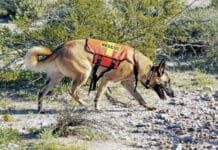There are generally six types of sounds that dogs use in order to vocally communicate with humans or with other canines. Most noises dogs make indicate some form of frustration, like when a dog whines to go outside. But dogs will also vocalize pleasure – and happy dog noises don’t always sound too friendly! Here’s a rundown of what dog sounds might mean:
1. Barking
Why do dogs bark? Dogs bark for many reasons, including alert (there’s something out there!), alarm (there’s something bad out there) boredom, demand, fear, suspicion, distress, and pleasure (play). If you know how to tell between different kinds of dog barks, you can easily understand why your dog is so vocal in the first place! Believe it or not, dogs’ vocal communication methods aren’t just for annoying neighbors – they’re for telling you something important has happened!
The bark of a distressed dog, such as a dog who suffers from isolation or separation distress or anxiety, is high-pitched and repetitive; getting higher in pitch as the dog becomes more upset. Boredom barking tends to be more of a repetitive monotone. Alert bark is likely to be a sharp, staccato sound; alarm barking adds a note of intensity to the alert.
Demand barks are sharp and persistent, and directed at the human who could/should ostensibly provide whatever the dog demands. At least, the dog thinks so. Suspicious barks are usually low in tone, and slow, while fearful barking is often low but faster. Play barking just sounds . . . playful. If you have any doubt – look to see what the dog is doing. If he’s playing, it’s probably play barking.
2. Baying
Baying is deep-throated, prolonged barking, most often heard when a dog is in pursuit of prey, but also sometimes offered by a dog who is challenging an intruder. The scent hounds are notorious for their melodic baying voices. Some people interpret dog baying a long moaning sound.
3. Growling
Growls are most often a warning that serious aggression may ensue if you persist in whatever you’re doing, or what-ever is going on around him. Rather than taking offense at your dog’s growl, heed his warning, and figure out how to make him more comfortable with the situation.
If instead of a hostile growl, your dog is grumbling lowly, he may be perfectly happy! Dogs also growl in play. It’s common for a dog to growl while playing tug – and that’s perfectly appropriate as long as the rest of his body language says he’s playing. If there’s any doubt in your mind, take a break from play to let him calm down. Some dogs also growl in pleasure. Rottweilers are notorious for “grumbling” when being petted and playing, and absent any signs of stress, this is interpreted as a “feels good” happy dog noise.
4. Howling
Howling is often triggered by a high-pitched sound; many dogs howl at the sound of fire and police sirens. (Two of my own dogs howl when our donkey brays). Some dog owners have taught their dogs to howl on cue, such as the owner howling.
Howling is generally considered to be communication between pack members: perhaps to locate another pack member, or to call the pack for hunting. Some dogs howl when they are significantly distressed – again, a common symptom of isolation and separation distress.

5. Whimpering Sounds/Yelping
A whimper or a yelp is often an indication that a dog is in pain. This may happen when dogs play, if one dog bites the other dog too hard. The whimper or yelp is used to communicate the dog’s distress to a pack member (or human) when they are friendly. The other dog or human is expected to react positively to the communication. Whimpers can also indicate strong excitement such as when an owner returns at the end of a long workday. Excitement whimpering is often accompanied by licking, jumping, and barking. Dog whimpering is softer and less intense than whining. Puppy crying sounds are just little whimpers.
6. Whining
Dog whining sounds are high-pitched vocalizations, often produced nasally with the mouth closed. A dog may whine when it wants something, needs or wants to go outside, feels frustrated by leash restraint, is separated from a valued companion (human or otherwise), or just wants attention. It is usually an indication of some increased level of stress for the dog. Most often the dog crying sound is an exaggerated whine or whimper.
Speaking Words?
Some dogs are capable of replicating human speech sounds. When these sounds are selectively reinforced, dogs can appear to be speaking human words, sometimes even sentences. It is most likely that the dogs have no concept of the meaning behind the words they are “speaking” – although as we learn more about canine cognition, one can’t ever be too sure.
It’s interesting to note that one of the phrases most frequently taught to dogs by their owners is some version of, “I love you…” Youtube provides some entertaining footage of talking dogs, like this one.







What does snorting mean?
Our newly adopted Maltese is afraid of my husband but goes to him for treats. She always “sings” and snorts around him. What does it mean?
Our adopted chihuahua mix dog, also afraid of my husband (unless he has treats), snorts at him if he tries to play with her. Vandi Hanin – did you ever get an answer?
I know my dog snorts during play, usually its because they are happy or are saying I am just playing. It is often used when dogs play with others.
It most likely means the dog is allergic to his cologne if he wears any they snort when their nose gets irritated
My dog howls and swishes his tail when I come home from shopping and he is anticipating a meaty bone.
You mentioned dog purring in the introduction but it’s never mentioned again. Chekov’s gun — If you’re going to set it up, you gotta pay it off.
I was hoping for this explanation as well as my dog purrs a lot!
My boy has begun softly grumbling and yipping shortly after lights out at night. Taking him outside stops it momentarily, but it starts up again in a few minutes and continues until I tell him to stop. Why????
My dog was doing the same so i left the light on for couple nights and she stop i left a night light and she is okay i guess is her. Eyes or vision problem..
you didn’t mention “sneezing’ when happy.
Yeah, what about the purring??
Although I’m pretty sure it’s a sign of contentment I was hoping the article would go over that too. Both my last lab and my current lab occasionally ‘purr’, usually when they are laying down and I am petting them. I thought they learned it from the cats, LOL.
What about mooing? My dog sounds like a cow 98% of the time and a lot of the time it’s not no reason that I can see
I’ve read these categories with interest and have noticed another not mentioned, Our rescue terrier mix is gradually becoming her own best doggo, and makes talking-type sounds, totally different from her barking, when she bounces into a room, or greets us. These sounds are very chatty, friendly greetings, and it seems like she is telling us something as she is very direct, making eye contact, open mouth and happy. She doesn’t use this chat to our other dog, but only to us. Noises are rumbly, sound like several syllables or words….we always think she’s telling about something she’s seen outside, or trying to communicate. It’s not demand barking, and not that “I wuv yoo” stuff either. We always give positive reinforcement when she does it; it’s too cute. Any thoughts?
I think what your dog does is precious! And YES, I too believe that in their own way, they ARE trying to “talk” in a manner that they believe is akin to ours. Their goal? That we, of course, will FINALLY understand them!😉
Our dog has to have the last word. He will bark and we say something back, he always talks (barks or makes a small noise) back. We have to hear his last word before he is satisfied. It is so funny!
My dog does what I think sounds like a Chewbacca sound when she does a downward dog for me. It’s the cutest thing ever, and have never had a dog do that before, and have always had dogs. They are each special and unique. ♥️
Mine does too. When he’s happy too. What breed is your dog
does anybody know why my dog randomly make a pig/whistle noise for seemingly no reason
My dog snoring so really bad do any body no way?
My Doberman grumbles, not growls, when I don’t go in a particular room to watch TV. He likes one room better than the other. Also grumbles when he feels I haven’t given his dinner soon enough.
My dog makes a loud, whiny, Chewbacca sound. when he wakes up, he will grab a toy and walk around, thumping his tail and groaning and it is super funny, but nobody knows why he does it!! does anybody have the same “problem”?
My son and his girlfriend have a 6 mos american bulldog. They met up with a friend the dog was in the car. They let him out to say hi then put him back in the car. They stood beside the car the dog was looking it, barking, talking etc wanted to be with the friend. The dog wouldn’t listen, wouldn’t stop. Embarrassing!
My dog started making strange shopping noises. Some times when he declines a treat he will do it. Does anyone know what this means? Thank you.
*Chomping
Question my dog always waits to be told to eat when I give him food, today when I told him he could eat he made a growling sound, my mum says it isn’t a growl I say it is any thoughts?
Could be a grumble, my Border Collie grumbles when he is either slightly annoyed at being fed late or when we leave him in the car.
My BC/spaniel mix always “talked” by grumbling at humans he liked. He did it with us, and with one lady who worked at the kennel he stayed at when we had to travel without him. They had a special relationship. He’s been gone 11 years; still miss him daily.
MY DOG IS UNDER THE BED (HE SLEEPS THERE) WHIMPPERING AND MAKING A CRYING SOUND AND YELPING. I THINK HE IS IN PAIN. WILL SOMEON ANSWER AND LET ME KNOW IF THIS IS SERIOUS PLEASE?
Are there monsters under there?
If he’s sleeping, it could just be a bad dream. I had a pointer that when he was in deep REM sleep would not only move his legs like he was running but also make quite loud vocalizations. Woofs and whines.
I’ve got a husky mix that scolds me when dinner is late. The rawrh rawrh type of talking scolding.
I used to talk to my Caesar all of the time. As he got older, he started to make vocalizations that weren’t any sort of bark or growl. I often thought he was trying to imitate my speech (but not very successfully.) I would answer him so perhaps was reinforcing the vocalizations as they always got my attention which is perhaps what he wanted.
Something was wrong with my almost 2 yr.old dog (he is a mix of Maltese and Chihuahua) so I went outside to get him some grass and closed the metal door behind me call me crazy but my 20 yr old daughter and I clearly heard heard him say “Don’t go” and “Mom come”.
Setters are known for “rooing.” I have three and two of them love to do it, different octaves, like a noisy duet. They are obviously talking to me, usually because we’re about to play, or to let me know that’s it’s time to do so. Occasionally, my Irish Setter will come in the room and very clearly tell me I am needed…usually my third dog wants to be let out. They’re not howling, their lips curl over their teeth to create a kind of “ooo” expression and then they let go…roo-rooo-rooooo-roo-roooo-roo. It’s one of the reasons I have Setters because it’s so cute!
We have a Golden Irish, we think that is what he is, and he will sing away when barking doesn’t get the reaction he wants. He keeps doing it for several minutes, unless he sees someone.